It seems that warmer spring temperatures have finally found us, hurray!
That of course also means that warmer temperatures are waking up pests.
Flea beetles have shown up in force in southern New England, but are likely to be truly ramping up their activity now that we have some more favorable temperatures. Combine that with fairly favorable conditions for cabbage maggot and sightings of imported cabbageworm moths in Massachusetts, and you’ve got more than enough reason to be thankful for row cover on brassica crops.
Spinach/beet leafminers appear to be picking up in southern New England as well, so it’s good to start getting in the habit of regularly checking any uncovered plantings of spinach, beets or chard for eggs (or covering with row cover).
Note: Click on the photos for an enlarged view.
Contaminated and/or Adulterated Neem Oil
CONTAMINATED AND/OR ADULTERATED NEEM OIL
The Pennsylvania Department of Agriculture found the synthetic pesticide materials malathion, chlorpyrifos, and permethrin in ‘Triple Action Neem Oil’ manufactured by Southern Agricultural Insecticides Inc in Palmetto, FL (EPA Reg. No. 70051-2-829, ME Product Number: 2016000126). The material is OMRI listed and only labeled to contain neem oil as an active ingredient. It is marketed towards homeowners, so there is concern that a home gardener may think they have a low-risk product and inadvertently be exposing themselves to a restricted-use pesticide.
It’s advised to stop use, and discard, if you currently have any of this material. More information here.
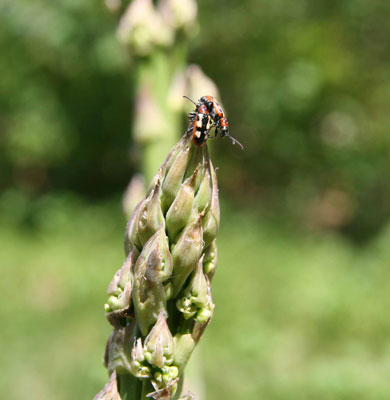 |
| Common asparagus beetles |
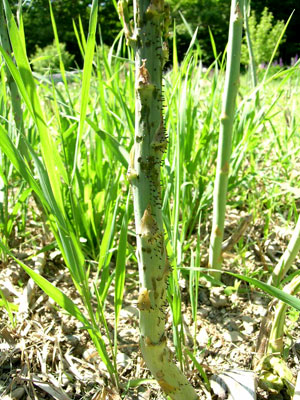 |
| Common asparagus beetle eggs |
ASPARAGUS BEETLE, COMMON AND SPOTTED
By Eric Sideman
First Let Me Discuss Frost
One of the very first questions I received when I began working for MOFGA many, many years ago turned into an argument. Not a good start for my tenure, but I stuck it out. The guy who called would not believe me that asparagus is frost sensitive. His spears had turned dark, wrinkled and water-soaked. I don’t know if I ever convinced him that the problem was they were frosted. Perhaps he is reading this.
Asparagus, despite its status as a primo early season vegetable, is highly sensitive to frost, ranking alongside cucumber, snap beans, eggplant and tomatoes in the ‘most susceptible’ category. There is still a chance of frost.
When frosted, spears appear slightly darker green, water-soaked and break off easily. Thawed spears become mushy. Soft-rotting bacteria can enter the damaged tissue. New spears take several more days to emerge, but will. Temperatures below 33 degrees Fahrenheit may damage the spears.
The Beetles
I have seen both kinds of asparagus beetles here already. Usually the spotted asparagus beetle becomes active somewhat later in the spring, and in my experience is less common (I guess with the names that is not a surprise). These two beetles are closely related and have similar life cycles, but it is the common asparagus beetle that is most damaging to the spears.
Common asparagus beetle (Crioceris asparigi) is blue-black, shiny, smooth and about 6 to 9 mm (1/4 inch) long, with three large yellow, squarish spots with red margins along each wing cover. Eggs are black, laid standing on end in rows along the spears, and hatch in 3-8 days. Larvae are wrinkled, plump, hump-backed, and dull gray with black head and legs. Some people call them “worms”. They grow up to 1/3 inch. These larvae feed in spears and in ferns. The larvae do the most damage, and eggs and larval damage makes spears unmarketable. Larval feeding can cause severe defoliation and weaken the stand. When full grown, larvae drop to the soil and pupate underground. New adults emerge in July, feed in ferns, and by September are looking for overwintering sites. Both species spend the winter as adult beetles either in field borders or within the asparagus field. Sheltered sites such as under bark or in the stems of old plants are preferred. Some burrow into the soil.
Spotted asparagus beetle (Crioceris duodecimpunctata) is reddish orange or tan, with six black spots on each wing cover (hence its other name, 12-spotted asparagus beetle). Eggs are greenish, glued singly on their sides to leaves. Eggs are laid on fronds, not on spears. Larvae are similar to those described above, but are orange colored, and feed almost entirely inside the berries so they affect seed production but do not hurt the plants.
Cultural Controls
During harvest, you can greatly reduce the population by harvesting ALL of the ready spears every harvest. Do not allow any spears to develop into fronds until you are all done harvesting for the season. This reduces the number of stems where eggs will survive, and larvae can feed and grow up into the summer-generation beetles.
In the fall remove all of the crop residue and other refuse nearby that provides shelter for adults over winter. Maintaining a clean environment in the fall will force beetles to seek shelter outside the field or burrow in the soil, where many predators reside.
Biocontrol
The most important natural enemy of common asparagus beetle is a tiny parasitic wasp (Tetrastichus asparagi) that attacks the egg stage. Wasps kill eggs by feeding on them (sucking them dry), and also lay their own eggs inside the beetle eggs. The immature wasps grow inside the beetle larvae, killing them when they pupate. Studies have found >50% of eggs killed by feeding and half of the surviving larvae parasitized. Providing a nearby nectar source such as umbelliferous flowers may enhance wasp populations.
Monitoring and Chemical Control
Scout fields regularly. You may want to treat spears if >10% of the plants are infested with beetles. The daily harvest makes treatment difficult because few want to spray anything close to harvest time. Treating infested fronds is important. Organic options include Entrust (Monterey Garden Spray for gardeners). Surround WP may work as a repellent.
Thanks to: Ruth Hazzard (U. Mass Vegetable Notes & The New England Vegetable Management Guide), and Brian Caldwell, Cornell University
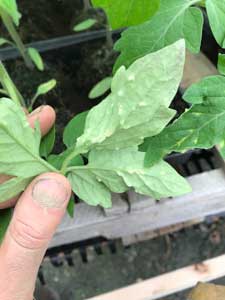 |
| Edema on tomato |
EDEMA (OEDEMA)
With lots of tomato seedlings waiting through the cloudy cold days and the sunny warm days, it’s common for folks to fear they have a disease on their. It is also a common problem in plants in the cabbage family, and some house plants. They see blisters or bumps on the surface of the leaves, most often the underside. The swellings initially appear pale-green, but they can erupt and turn yellow, brown or even black. Eventually, corky spots appear on the underside of the leaves. Older leaves are more often affected than younger leaves.
Edema is not a disease caused by a pathogen, but rathera physiological disorder that develops when a plant absorbs water faster than it can be lost from the leaf surface. Excess moisture builds and the blisters form. This is most commonly induced when transpiration is limited. Transpiration (the natural loss of water from the plant) is reduced by cloudy days,humid conditions in a greenhouse, cool temperatures, low light levels such as when plants are raised on a windowsill in a home, etc. Overwatering under these conditions is commonly the biggest factor causing the problem.
Leaves affected with edema never clear up, but there are steps to be taken to prevent more of the problem:
- Cut back on watering when conditions favor edema, but, of course, do not let the plants completely dry out.
- Water only in the morning
- Supplement lighting if it is low
- Increase ventilation and avoid over-crowding plants
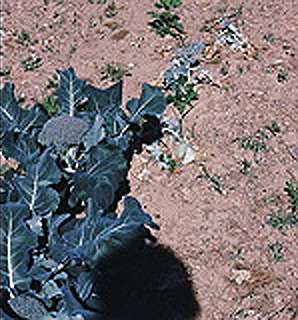 |
| Cabbage maggot damage on broccoli. The row cover was about 10 feet too short and the cabbage maggot got the last few plants! |
CABBAGE AND ONION MAGGOT
Reprinted and modified from Umass Veg Notes
Onion maggot (Delia antiqua) and cabbage maggot (Delia radicum) flies look nearly identical but are likely to be found only on or near their host crop. The seedcorn maggot is the earliest of the vegetable crop maggots, but now is when the onion and cabbage maggots are becoming the concern. Cabbage root maggot attacks all types of brassica crops, while onion maggots are highly specific for the onion family including onions, garlic, leeks, chives, and shallots. A good indicator of the start of cabbage root maggot flight is blooming of the common roadside weed, yellow rocket.
Life cycle
Onion and cabbage maggot flies spend the winter as small brown pupae in the soil. Adults emerge in spring and adults can travel considerable distances in search of host plants (1/2 to 1 mile). Cabbage root maggot flies are rather delicate, hump-backed gray-brown flies, about 5-7 mm long. Onion maggot flies are very similar. Female flies seek out their host crop to lay eggs at the base of the stem. Cool, moist soil conditions favor survival of the eggs, while soil temperatures over 95 F kill them. When the soil temperatures in the upper half to 1 inch are high (>100 degrees F) that soil temperature itself then provides control. This is the reason these pests are much more of a problem in the spring, and summer generations of the pest are rarely noticed.
When eggs hatch, larvae feed on roots and can cause complete destruction of the root system. In crops such as broccoli or cauliflower the first sign of a problem is wilting of the plant on sunny days and yellowing of outer leaves. Later, plants collapse, wilt down, and die. If you pull one up you will see that damaged/eaten roots are why is was wilting. You may find the legless white maggots feeding, or the small brown, oblong pupae. In brassica root crops such as turnips, radishes and daikon, feeding tunnels make the root unmarketable.
In onions, newly hatched larvae crawl behind the leaf sheath and enter the bulb, and feed on the roots, stem, and developing bulb. Feeding damage also encourages entry of soft rot pathogens.
The first flight and egg-laying period is generally most intense in the first half of May in Massachusetts, depending on accumulated growing degree days – thus, it will vary with the season and location. After the first flight is over, and as soils heat up, fewer eggs are laid and those that are laid are less likely to survive. I have observed that in most years that brassica transplants set out after the flowers fall from forsythia did not suffer damaging infestations of cabbage maggots. In cooler areas of the state, however, scouting has sometimes found damaging levels into June. Each season will be different. It is impossible to name a consistent and reliable date after which it is safe to plant onions or brassica crops, but late May into June will likely be safer than the first half of May. So, if you are seeing damage, there is still time to do another planting of onions and be less at risk. And, there is time for many more plantings of brassica crops.
Monitoring
Flies are attracted to bright yellow colors. Yellow sticky cards (3X5 inches) are inexpensive and easy to use; attach them with small wire stakes and place near the soil. Check and change traps twice weekly to record changes in fly activity. Sources: Great Lakes IPM, Gemplers
Using Growing Degree Days – The beginning and peak of each fly generation can be forecasted using degree day accumulations. Most growing degree day information for plants and insects is based on a base temperature of 50 F, but maggot flies are active at a lower base temperature of 40 F. For more information on using growing degree days, go to https://ag.umass.edu/vegetable/fact-sheets/cabbage-root-maggot. Or skip right to the NEWA cabbage maggot model to see when peak flight is forecasted to occur, by choosing the weather station closest to you: https://newa.cornell.edu/index.php?page=cabbage-magot
Control
Floating row covers provide an effective barrier against these pests. Place the cover on as soon as the transplants are set. Use in a rotated field, as flies overwinter in soil after late season crucifers and could emerge under the cover if the same field has spring brassicas. Replace cover after weeding operations. As soil temperatures rise, the first flight ends and crops grow large, covers can be safely removed.
Crop rotation contributes to keeping populations low; greater distances are more effective. Fall tillage to bury crop residues and to expose over-wintering pupae is also important. For onions, bury or haul away onion cull piles. Rotting onion smell attracts the onion maggot fly. In a vigorous Brassica crop, cultivation that brings soil up around the stem may help encourage formation of adventitious roots from the stem, which can help compensate for root loss even if maggots are present.
Naturally-occurring fungal diseases occasionally will reduce onion maggot numbers significantly, particularly when flies are abundant and relative humidity is high. During a fungal epidemic dead, diseased flies, can be seen clinging to the highest parts of plants along field edges. Predaceous ground beetles, which eat onion maggot eggs, larvae and pupae, can also be important in reducing maggot numbers.
Thanks to Ruth Hazzard. References: Network for Environment and Weather Applications (NEWA) of NYS IPM Program; Ontario Ministry of Agriculture, Food and Rural Affairs online fact sheet
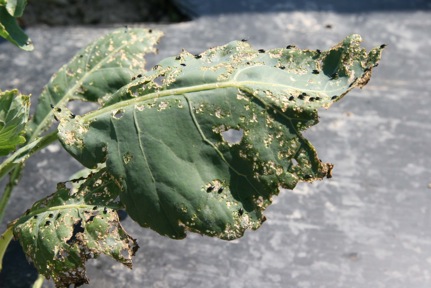 |
| Flea beetles on broccoli leaf |
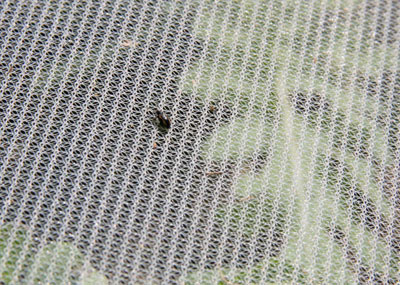 |
| Flea beetle trying to get through Proteknet. |
FLEA BEETLES IN BRASSICAS
Flea beetle numbers are likely to rise in coming weeks here in Maine as beetles move out of field borders where they spent the winter. Crucifer and striped flea beetles feed on Brassica crops as well as weeds that are in the same family, such as yellow rocket or wild mustard. [It is a different species of flea beetles that feeds on the tomato family of crops. This is important information when planning rotations of potatoes or tomatoes with Brassica cash or cover crops].
The crucifer flea beetle (Phyllotreta cruciferae) is uniformly black and shiny, about 2 mm in length, while the striped flea beetle (Phyllotreta striolata) has two yellow stripes on its back. Flea beetle adults feed on leaves and stems, resulting in numerous small holes, or ‘shot-holes’. Eggs are laid in the soil starting in late May, and beetle larvae feed on roots.The non-waxy greens (arugula, bok choi, tatsoi, mustard, Chinese cabbage, komatsuna) are preferred to the waxy cabbage, kale and collard types of brassicas. In brassica greens, beetles feed on the whole surface of the leaf, and will continue feeding from the seedling stage until harvest. Waxy crops are most susceptible at the cotyledon and seedling stage and feeding is more limited to leaf margins on older plants. Some crops simply outgrow the beetle pressure and the damage can be tolerated. No damage can be tolerated in leafy greens crops such as arugula.
To reduce and delay flea beetle invasion of spring crops, move them as far away as possible from the fields that were used for Brassica crops last fall. Beetles overwinter in field borders near last year’s crop. Planting the same crop close by to where it was last year ensures a high population in the spring. The same could be true if you have fields full of mustard weeds.
One of the best ways to protect Brassica crops from flea beetles is to place a floating row cover, or exclusion netting, over the bed or row. It is critical to seal the edges immediately after seeding or transplanting, because Brassica seeds germinate quickly and beetles rapidly find the cotyledons. Flea beetles can fit through extremely tiny cracks. Edges of the cover must be sealed on all sides using soil, plastic bags filled with soil, or some other method.
Spinosad (Entrust is organic formulation for farmers, and Monterey Garden Spray is one for gardeners) is sometimes effective in suppressing flea beetles and reducing damage. Pyrethrin (Pyganic) showed poor to moderate efficacy in trials, and has a short residual period. Yet some growers have reported a good knockdown with this product.
SPINACH/BEET LEAFMINERS – Spinach leafminer (Pegomya hyoscyami) and beet leafminer (Pegomya betae)
These two species of leafminer attack spinach, beet, chard, and some weeds, such as lambsquarters. The spinach leafminer is more common. The adult is a fly that lays its eggs on the under- sides of leaves. The eggs hatch in as few as three days, depending on temperature. The tiny, pale maggots tunnel into the interior of the leaf to feed on cells, leaving pale mines that, when numerous, run together to form necrotic, blister-like areas. The damage is usually cosmetic, not impacting yield, BUT, it ruins the marketability of greens such as chard or spinach, etc. When fully grown, the larvae drop out of the leaf to the ground and pupate in the soil. Leafminers overwinter in the soil as pupae and emerge in the mid spring. Rotation is really important, especially if you are trying to use netting or row covers to exclude the fly.
Controls include:
- Destroying crops at the end of harvest and controlling weeds, especially lambsquarters, chickweed, and plantain is important for reducing the number of overwintering pupae.
- Deep plowing can bury pupae and reduce the number of emerging flies the following spring.
- Row covers and netting if the ground is sure to not have overwintering pupae already.
- Since spinosad (Entrust, Monterey Garden Spray for gardeners) penetrates leaves to some extent, some farmers claim that it is effective against leafminers. It will be most effective if applied before eggs hatch and larvae penetrate the leaf.
